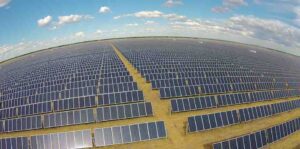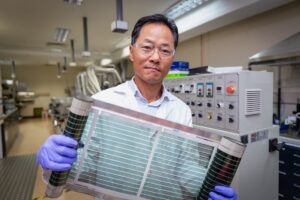Four Australian and Chinese solar pioneers engineers have been presented with the world’s most coveted engineering prize for their work in helping slash solar costs by 80 per cent in the last decade and fast-track the global uptake of solar technology.
The four – Professor Martin Green of UNSW, Professor Andrew Blakers of ANU, and Dr Aihua Wang and Dr Jianhua Zhao – were named winners of the 2023 Queen Elizabeth Prize for Engineering (the QEPRize) prizes earlier this year for their invention and refinement of the Passivated Emitter and Rear Cell (PERC) solar cells.
They were presented with their awards by King Charles in a ceremony at Buckingham Palace on Thursday (UK time).
The Queen Elizabeth Prize for Engineering (the QEPRize) is awarded annually to engineers of any nationality that have invented ground-breaking technologies of global benefit to humanity.
“As engineers, we are constantly striving to improve the world we live in,” said Green.
“As the world feels the devastating impacts of our changing environment and collapsing ecosystems, I feel passionately that we must rapidly reduce our reliance on fossil fuels if we wish to maintain the trajectory of human civilisation on our shared planet.
“I hope that PERC technology winning the QEPrize will highlight the importance of accelerated solar adoption to address climate change.”
PERC cells revolutionised the conventional silicon photovoltaic cell, which typically contains two layers of silicon that provide negative and positive charge.
In a typical silicon solar cell, sunlight hitting the cell causes electrons to break free from the negative layer and be passed to the positive layer, creating an electric field. These types of cells are typically plagued by problems of efficiency loss.
PERC cells, first introduced in 1989, are modified silicon cells with an additional, reflective layer on the back that captures unused light and returns it to the first two layers, harnessing more of the sun’s energy in the process.
The back layer also prevents the build-up of heat that would otherwise hinder the cell’s performance over time.
PERC cells now account for almost 90% of the global market.
Alongside Green, this year’s QEPrize was awarded to Professor Andrew Blakers of ANU, Dr Aihua Wang and Dr Jianhua Zhao, for their invention and refinement of the PERC cell.
Before PERC cells, scientists believed that the maximum practical efficiency for a solar cell sat at around 20%, but over four decades, Green, Blakers, Wang and Zhao of this year’s QEPrize worked to prove that the maximum achievable efficiency of their technology was 25%.
Dr Wang and Dr Zhao, solar’s very own power couple, spent sixteen years working on PERC cells at UNSW in Australia, before returning to China where they continue to advance solar research.
The four awardees published their findings without patenting, allowing the technology to be taken up widely and at low-cost, and massively advancing the solar market, which now accounts for 4.5% of total global electricity generation, and 14% of Australia’s electricity generation.
“Achievements in engineering can have a remarkable impact all over the world and we are very grateful that the Queen Elizabeth Prize for Engineering has selected PERC technology among many global innovations,” said Dr Wang.
“It is my pleasure to share this award among friends and colleagues who each played a critical role in achieving the energy efficiency target.”
PERC may have revolutionised the solar industry, but the efficiency improvement potential of PERC cells is now thought to have been exhausted. Scientists are now looking beyond PERC to take solar even further.
Some other options in-silico include n-PERT (passivated emitter rear totally diffused), n-TOPCon (tunnel oxide passivated contact), heterojunction (HJT) and interdigitated back contact (IBC).
Beyond silicon, as of 2023 a single-junction perovskite solar cell had achieved a maximum efficiency of 25.7%. check
Perovskite, otherwise known as calcium titanate (perovskite materials can more broadly refer to other materials with the same crystalline structure as calcium titanate), has the potential to reduce costs and improve efficiency even further.
While commercialisation of perovskite solar cells has been hampered by stability and durability concerns, a recent analysis by Rethink Energy estimated that perovskite would account for 85% of the solar industry’s output by 2040, with close to 1TW of production per year.










